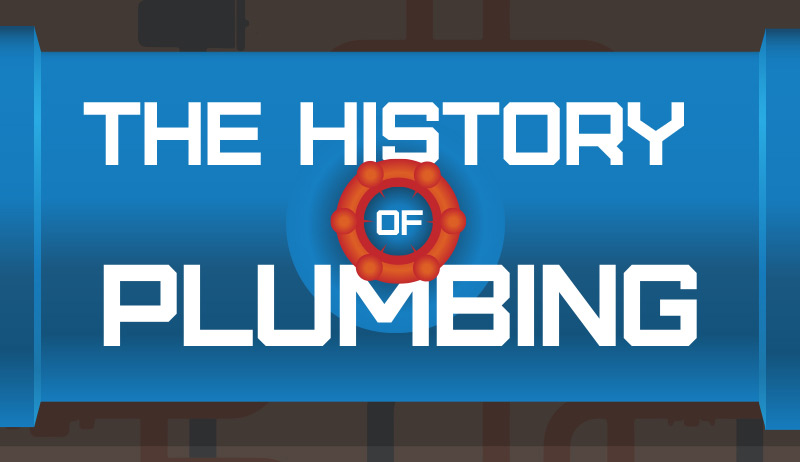Typically, people don’t think about plumbing services until they need to. As long as the toilet is not plugged up, the water heater is heating to our liking and there are no leaks in the water supply, plumbing is mostly taken for granted.
But plumbing was not always what it was today. In fact, it has a long history dating back to ancient civilizations, with many milestones and innovations along the way. In this infographic, Allen Plumbing Company takes a look at the history of plumbing and learn how much it has progressed over the years.
[Click image for full size version]
The History of Plumbing
Typically, people don’t think about their plumbing systems until something goes wrong, and it’s certainly something that we take advantage of in our everyday lives. It is a wonderful invention that we’re sure everyone would be sad to lose.
But plumbing was not always what it is today. In fact, it has a rather long history dating back to ancient civilizations, with many milestones and innovations along the way.
From Ancient Civilizations to Now
4000-3000 B.C.
Copper pipes already – who knew?
In the Indus River Valley of India, archaeologists discovered the first copper water pipes.
2500 B.C.
Pipes in the Pyramids – who knew?
Water was used in a variety of rituals in Egyptian culture, and the Egyptians had become adept at “drainage construction” during this time. They used copper pipes for bathrooms inside the pyramids.
1500 B.C.
The first royal flush
King Minos of Crete allegedly introduced the early version of flushing toilets as part of “complex sewage disposal systems.”
52 A.D.
Plumbing made decadent
As one of the pioneers in plumbing, Rome announced that they had created an estimated 220 miles of aqueducts, water channels, and pipes. By 4th century A.D., Rome used their advancements to supply 11 public baths, 856 private baths, and 1,352 private fountains and cisterns.
700-1500 A.D.
A real crappy era
This time was named the “dark ages of plumbing and hygiene” due to the lack of sanitation and rising disease.
1596
The second royal flush
Sir John Harrington, the godson of Queen Elizabeth, invents the first flushing toilet.
1728
Methane goes underground
After health officials in New York had received numerous complaints about the smell of open sewers, the first underground sewer was installed.
1775
The commoner flush
Englishman, Alexander Cummings patents the flushing toilet as we know it today.
1829
Going into the closet
The Tremont Hotel of Boston is the first hotel to have indoor plumbing. The hotel included 8 “water closets” built by Isiah Rogers. People began using soap during bathing for obvious hygienic reasons.
1833
Presidential ‘aplumb’
Plumbing was installed in the first floor of the White House. 20 years later, plumbing was installed upstairs during Franklin Pierce’s time in office.
1848
Code of johner
England passed The National Public Health Act and led the path to improved public health. Most of the world began adopting the code.
1885
Sewer rat gets a home
Chicago installed the first comprehensive sewer system in the US. However, during this time, residents still had to use public bathing facilities, which cost five cents for audits and three cents for children.
Early 1900’s
Tanks get tanked
Laws were put into place requiring many areas of the country to install plumbing systems with a minimum number of fixtures. Toilet designs evolved from the elevated water tank into the modern toilet which has a tank and a bowl.
1961
And flushing for all
All buildings and facilities were required to be accessible to the physically handicapped. This included bathroom facilities.
1986
The high tech flush
Japan introduced the first sensor-flushing toilet.
1992
The green flush
The Energy Policy Act was passed and restricted water flow rates in plumbing fixtures. Low-flow toilets were soon invented to conserve water.
The Future of Plumbing
Plumbing as we know it hasn’t finished evolving. In fact, there is a whole industry dedicated to finding ways to make plumbing better, easier, and less expensive.
Future plumbing technology might include self-cleaning toilets and hands-free toilets. Wouldn’t be nice to live in that world?
Interesting Plumbing Facts
Here are some interesting plumbing facts:
- The average person spends three years of his/her life sitting on the toilet.
- The toilet is flushed more times during the halftime of the Super Bowl than any other time of the year.
- The Plumbers and Steamfitters Union made Albert Einstein an honorary member because Einstein said if he could live his life all over again, he’d be a plumber.
- King George II died on the toilet in 1760 from an aortic dissection
- According to a $100,000 study on whether people prefer the toilet paper flap in front or behind, 75% of people prefer the flap in front.






